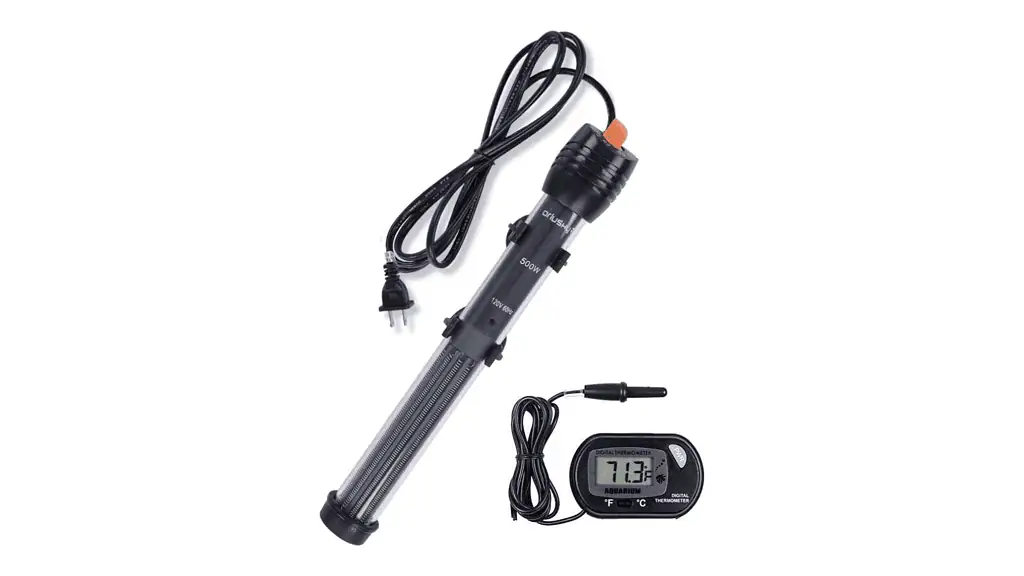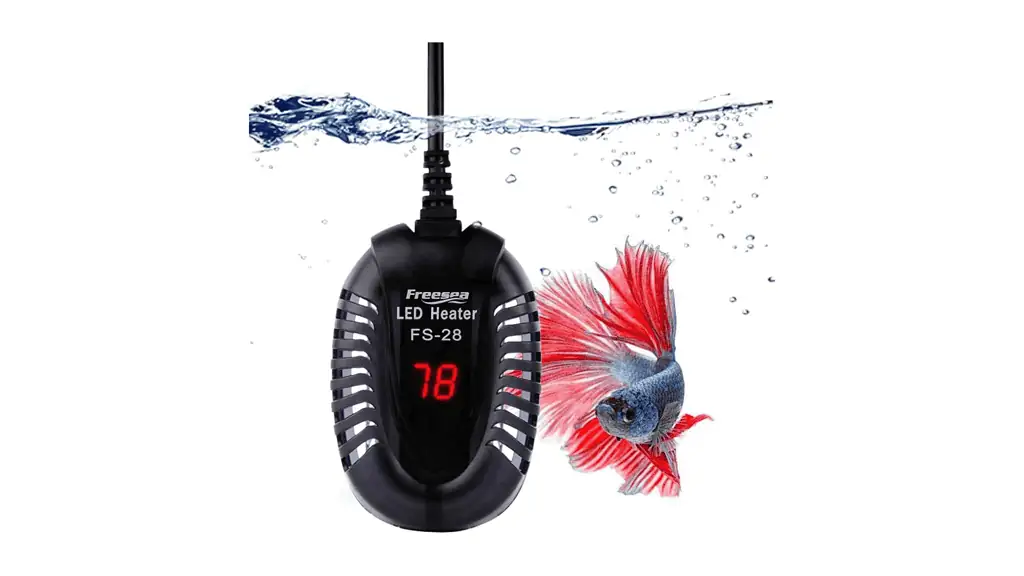An aquarium heater is one of the most important components of your betta’s habitat.
Bettas originated in the tropical climate of Southeast Asia. Without warm water temperatures, your betta cannot thrive.
Ambient room temperatures in your home are not warm enough for a betta tank.
A submersible aquarium heater maintains ideal temperatures in your betta.
There are many types of aquarium heaters available. They vary in price depending on how many advanced features they have.
So, what is our top pick for the best heater for a betta fish tank?
We like the Eheim Jager Aquarium Thermostat Heater for its reliability and ease of use. This adjustable heater is a favorite among betta fish owners because of its durability and affordable price.
The Eheim Jager Thermostat Heater also features a recalibration ring. This ensures the most accurate temperature readings.

Our Top 4 Choices of the Best Heaters for Betta Tanks
- Orlushy Submersible Aquarium Heater (Best for Large Tanks)
- Free Sea Mini Aquarium Heater (Best for Small Tanks)
- Eheim Jager Aquarium Thermostat Heater (Best Overall)
- Submersible Aquarium Heater (Best Controls)
Our Reviews for the 4 Best Heaters for Betta Tanks
Orlushy Submersible Aquarium Heater
- 6′-foot power cord
- Adjustable within 1-degree increments
- Includes digital thermometer
Orlushy’s Submersible Aquarium Heater is our top choice for larger betta fish tanks. It maintains consistent temperatures in larger tanks and has important safety features.
The 300-watt model is suitable for tank sizes from 40 to 55 gallons.
This heater has an adjustable temperature range between 68-89° degrees Fahrenheit (20-32° C). A dial on the top of the heater lets you adjust the temperature.
Made from 2mm-thick quartz glass, this heater is shatter-proof for extra safety. There is also an automatic shut-off feature when the heater reaches the desired temperature.
You must keep this heater submerged at all times. If the heater is above the water line, it can overheat.
The heater comes with a separate digital thermometer. This thermometer attaches to the outside of the tank via suction cups and has a probe you put in the water.
A 6′-foot power cord makes plugging in this heater more convenient.
Always refer to the temperature reading on the thermometer when using this heater. The temperature setting on the dial can vary by several degrees, according to many users.
Specs:
- Watts Available: 25-500 watts
- Tank Size Rating: 1-75 gallons
- Temperature Range: 68-89° degrees Fahrenheit (20-32° C)
- Safety Features: Shatter-proof, automatic shut-off at the desired temperature
- Special Features: External digital thermometer, 6′-foot power cord
Free Sea Mini Aquarium Heater
- 5′-foot power cord
- External controls
- LED temperature display
The FREESEA Mini Aquarium Heater is the best choice for smaller betta tanks. Its compact design does not take up a lot of space in your betta tank.
External temperature controls make adjustments easy.
This heater comes in 50, 75, and 100-watt versions. The 50-watt model heats tanks sized from 5-10 gallons.
An LED display screen shows the current temperature as well as any error codes. A red indicator light shows when the heater is warming up.
The heater provides extra safety with two automatic shut-off modes.
It shuts off when the heater is above the water level. There is also an automatic shut-off when temperatures go above 94° degrees Fahrenheit (34.4° C)
Quartz tubing inside the heating unit is shatter-proof. A plastic outer shell gives your betta protection against burns.
This heater has an adjustable temperature range between 63-94° degrees Fahrenheit (17.2-34.4° C). A digital display offers excellent readability.
An automatic memory function retains your pre-set temperature in the event of a power failure.
The external controller saves you from placing your hands in your betta tank. This avoids possible water contamination.
Strong suction cups keep the heater in place inside your betta tank.
Specs:
- Watts Available: 50-100 watts
- Tank Size Rating: 1-20 gallons
- Temperature Range: 63-94° degrees Fahrenheit (17.2-34.4° C)
- Safety Features: Shatter-proof, two auto shut-off features
- Special Features: External temperature controller, LED temperature display
Eheim Jager Aquarium Thermostat Heater
- Precise temperature regulation
- Thermo safety controls
- On/Off indicator light
The Eheim Jager Aquarium Thermostat Heater is our top choice for the best overall betta tank heater.
This quartz glass submersible heater maintains steady temperatures with reliable results.
Its shatter-proof glass construction protects against breakage and ensures even heating.
There are several wattage options available in this heater ranging from 25 to 300 watts.
This heater is adjustable with a temperature range of 65-93° degrees Fahrenheit (18.3-33.9° C). The adjustment ring lets you recalibrate the heater for accurate temperature readings.
An auto shut-off feature prevents the heater from turning on if it is not submerged in water.
A mounting bracket and suction cups ensure secure placement in your betta tank.
The Eheim Jager Thermostat Heater is one of the only aquarium heaters on the market with an accuracy of +/- 0.5 degrees.
Specs:
- Watts Available: 25-300 watts
- Tank Size Rating: 5-150 gallons
- Temperature Range: 65-93° degrees Fahrenheit (18.3-33.9° C)
- Safety Features: Shatter-proof, automatic shut-off
- Special Features: Recalibration ring, accurate within +/- 0.5 degrees
Submersible Aquarium Heater
- External temperature controller with LED display
- Memory function
- Impact-resistant glass
The AQQA Submersible Aquarium Heater gets our top vote for the best controls.
A cool feature of this heater is the external temperature controller. It features an LED display for the best readability.
This controller shows both the current water temperature and the set temperature. Indicator lights flash when the heater is warming up.
The heater consists of a nickel-chromium heating wire with silicon-carbide heat conduction. This ensures faster heating of your aquarium water.
A heat-resistant polycarbonate bumper guard protects your betta from getting burned.
Dual temperature probes on the heater provide an accurate temperature measurement. If one of these probes breaks, the heater does not turn on.
With a built-in memory function, you don’t have to worry about resetting your preferred temperature if the power goes out. When the power turns back on, your settings are still there.
Powerful suction cups attach the heater to your betta tank. An adjustable hook on the temperature controller lets you attach it to the side of your tank for easy viewing.
This heater has an adjustable temperature range of 68-93° degrees Fahrenheit (20-33.9° C). Automatic shut-off features prevent the heater from working above water or when water temperatures are too high.
Specs:
- Watts Available: 100-1,200 watts
- Tank Size Rating: 25-264 gallons
- Temperature Range: 68-93° degrees Fahrenheit (20-33.9° C)
- Safety Features: Shatter-proof quartz glass, polycarbonate protective shell, automatic shut-off modes
- Special Features: External temperature controller with LED light display, dual temperature probes
How To Choose a Heater for a Betta Tank
There are several factors you must consider when choosing a heater for your betta tank.
Aquarium heaters come in several sizes, and choosing the wrong one can cause a lot of problems for your betta.
There are a lot of affordable budget options available. But aquarium heaters with the lowest price are usually made of cheap components.
While you save money on your initial purchase, you may pay more over time for replacements.
Expensive aquarium heaters are not always the best options either.
The accuracy and durability of an aquarium heater depend on how well it’s made. Cheap thermostats and faulty temperature probes are the most common reasons why aquarium heaters fail.
Always read reviews and research an aquarium heater’s special features before you buy it.
Watts and Tank Size
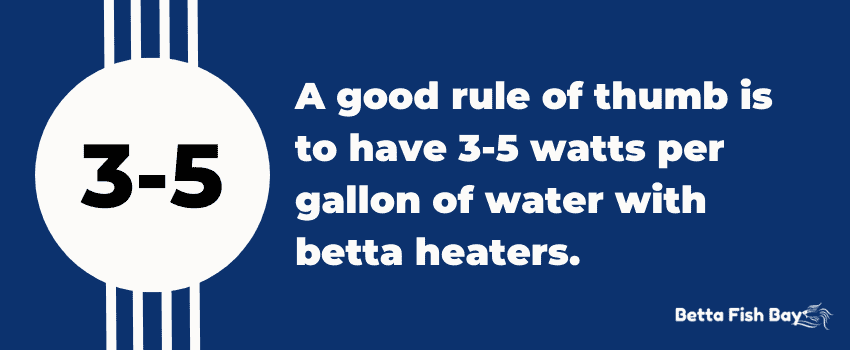
The wattage of your heater and the size of your aquarium depend on each other.
As a rule, a heater for a betta tank should provide 3-5 watts per gallon of water.
An aquarium heater with a high wattage output can overheat a 5-gallon tank in a short amount of time. Likewise, a heater with low wattage is not enough for a 55-gallon tank.
You must also consider the physical size of the aquarium heater versus the size of your betta tank.
Most submersible aquarium heaters must stay submerged for proper functioning. If any part of the heater sticks out above the waterline, it may stop working or overheat.
Measure the depth of your betta tank from the substrate to the surface. Compare this measurement to the aquarium heater and ensure it fits.
Some submersible aquarium heaters give you the option of horizontal or vertical placement. Read the instructions on your heater and ensure it is completely submersible.
Placing the heater sideways works well. But if the heater has a temperature dial, adjustments are a bit of a challenge.
You must also ensure the heater is not touching the substrate.
Many betta owners place their submersible heaters diagonally as well.
If you have a long tank, place the heater in a central location for more even water temperatures.
Adjustability
Aquarium heaters have pre-set or adjustable temperatures.
Pre-set aquarium heaters are usually calibrated to 78° degrees Fahrenheit (25.6° C). You cannot raise or lower this temperature.
Other submersible heaters have an adjustable temperature range. You raise or lower the temperature with a temperature dial or a separate controller.
Adjustable aquarium heaters are the best option for betta tanks.
Aquarium heaters are not always accurate and may vary by several degrees. Inaccurate temperate readings also occur when the thermostat is above the waterline.
Measuring the water temperature with a separate thermometer lets you check the accuracy of your heater.
If the actual water temperature differs from the heater setting, you must adjust. Always make small adjustments and check the temperatures again after 24 hours.
Pre-set aquarium heaters do not allow for these adjustments.
Readability
The next factor is the readability of the aquarium heater.
Consider an aquarium heater with a digital display if you have trouble reading a temperature scale.
Separate temperature controllers mounted outside of the tank have the best readability due to LED displays.
Always check your betta tank temperatures with a separate thermometer. Place the thermometer on the opposite end of the tank for the most accurate reading.
Aquarium heaters sometimes have false temperature readings. This is usually because the water closest to the heater is the warmest.
Built-in thermostats in heaters also fail from time to time. Even high-quality heaters can have faulty thermostats.
Submersible thermometers provide more accurate temperature readings than stick-on thermometers.
Ease of Use
Ease of use is another important factor when deciding on an aquarium heater for your betta.
Some heaters with a temperature dial are very sensitive. If the dial is too sensitive, you may decrease or increase the temperature too much by accident.
Choose an aquarium heater with a larger dial and readable temperature markings.
Heaters with temperature controllers are a great choice. They usually have buttons you press to raise or lower the temperature.
These temperature controllers may have digital displays for better readability. A separate controller also prevents you from putting your hand in the water when adjusting the temperature.
Ease of use also extends to the setup of your heater. Most aquarium heaters attach to your tank with suction cups.
Always read the instructions before setting up your aquarium heater.
With most heaters, you must submerge them in water for at least 30 minutes before you turn them on.
This acclimates the heater to your tank’s water temperature. If the heater is very cold when you turn it on, the glass can shatter due to the sudden temperature increase.
Some aquarium heaters also need calibration before using them for the first time.
Safety Features
Safety features in aquarium heaters protect you and your betta from injuries.
The most common safety feature in aquarium heaters is shatter-proof quartz glass.
This shatter-proof glass prevents your heater from breaking due to accidental bumps. Sudden temperature changes can break the glass, as well.
If the protective glass around the heating element breaks, it can electrocute you and your betta.
Another common safety feature is auto shut-off settings.
A built-in thermal protection circuit can turn the heater off if it overheats.
Overheating usually happens when the heater is no longer submerged under water. Water levels can decrease through water evaporation or during water changes.
Always turn your aquarium heater off for at least 30 minutes before performing a water change. This prevents the unit from overheating and reduces the risk of electrical shock.
Most aquarium heaters also shut off when they reach the pre-set temperature.
A built-in bumper guard is An important safety feature in some aquarium heaters.
Bumper guards are usually made from a heat-resistant material like polycarbonate.
The bumper guard is a cage around the glass containing the heating elements. This protects the glass from breaking due to bumps from objects in the aquarium.
A bumper guard also creates a buffer between your betta and the heated glass core.
Without a bumper guard, your betta can suffer from severe burns if it gets too close to the heater.
Where To Place the Heater in Your Betta Tank
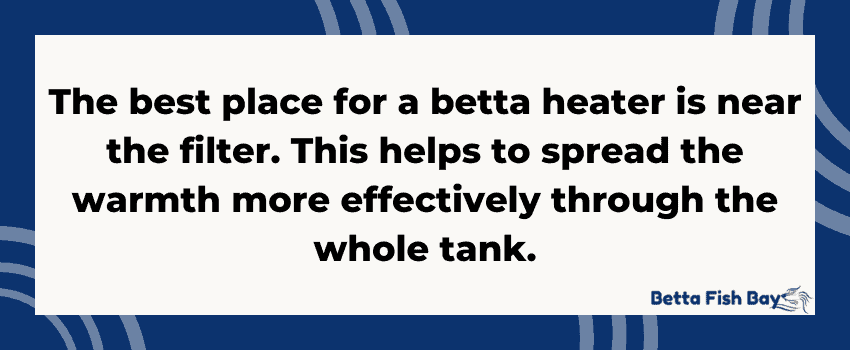
Most betta owners place their aquarium heater in the corner of the tank or behind some plants.
This helps conceal the heater and gives the tank a less cluttered look.
The best place for your aquarium heater is near the filter output.
Placing the heater near the filter helps circulate the warm water throughout the tank. This helps ensure no hot or cold spots in your betta tank.
Use a separate thermometer to check the temperatures in your betta tank’s different areas.
If you have cold spots in your betta’s water, ensure the heater is not faulty. You may need an aquarium heater with a higher wattage output.
Using two smaller aquarium heaters in a larger tank is usually better than having only one high-wattage heater.
Placing a smaller heater on each end creates more stable water temperatures throughout the aquarium.
Ensure the combined wattage of the two heaters suits the size of your betta tank.
Are Pre-Set Aquarium Heaters Safe for Bettas?
Pre-set aquarium heaters are less expensive than adjustable heaters. This is why they usually come included in many all-in-one aquarium kits.
The pre-set temperature in these aquarium heaters is almost always 78° degrees Fahrenheit (25.6° C).
When these heaters function in the right way, they do not pose a risk to your betta’s safety.
But due to their cheap components, pre-set heaters often measure above or below their set temperature.
This can create a dangerous situation for your betta.
If temperatures are much lower than 78° degrees Fahrenheit (25.6° C), your betta can suffer from lethargy and slow digestion.
When temperatures are well above the pre-set threshold, your betta can die.
Adjustable aquarium heaters cost a bit more but are much safer for your betta.
The Importance of Having a Separate Thermometer
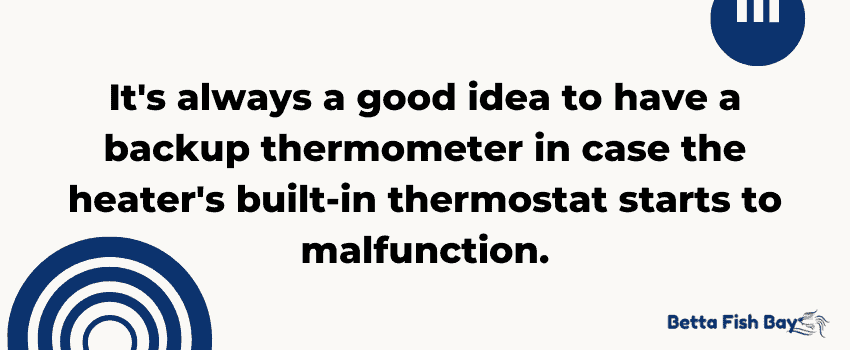
Any type of aquarium heater can malfunction, no matter how much it costs.
The most common cause of aquarium heater malfunctions is a faulty thermostat.
This is why having a separate thermometer is so important.
A separate thermometer lets you check actual water temperatures against the reading on your heater.
The highest-rated thermometer among fish tank owners is this one. It is very accurate with easy-to-read large numbers and has an affordable price.
This type of thermometer attaches to the inside of your tank with a strong magnet instead of suction cups.
A Closer Look at Our Top Picks for Betta Tank Heaters
We picked the Eheim Jager Aquarium Thermostat Heater as the best aquarium heater for a betta fish tank. It comes in a wide range of sizes for both small and large betta tanks and is well-known as a reliable aquarium heater.
The recalibration feature on this heater helps you ensure you have the correct temperature for your betta tank.
For the heater with the best controls, we chose the AQQA Submersible Aquarium Heater. This heater has a higher price than others on our list, but the cool features make it worth the expense.
The AQQA aquarium heater combines accuracy with ease of use with dual temperature probes and an LED display.
The FREESEA Mini Aquarium Heater is our favorite choice for smaller betta tanks. Its compact size and external temperature controls make it a perfect fit for 5- and 10-gallon tanks.
Frequently Asked Questions About Heaters for Betta Tanks
What temperature should the water be for betta fish?
Bettas are tropical fish from the warm waters of Southeast Asia.
The optimal temperature for bettas is between 78-80° degrees Fahrenheit (25.5-27° C).
Maintaining stable temperatures is essential for a betta’s health.
Sudden temperature fluctuations can lead to shock.
Low temperatures prevent proper digestion and may lead to bloating or constipation.
Hot temperatures increase a betta’s metabolism and cause premature aging.
Temperatures higher than 84° degrees Fahrenheit (28.9° C) can kill your betta.
How many watts should the heater be for a betta fish tank?
The wattage of your heater depends on the size of your betta tank.
As a general rule of thumb, aquarium heaters should have an output of 3-5 watts per gallon of water.
This means in a 10-gallon tank, you need a heater rated at 30-50 watts.
For tanks larger than 20 gallons, you may consider installing two heaters.
In a 40-gallon tank, two 100-watt heaters placed on each end of the tank can provide more even heating.
Should I Use A Submersible Or External Heater For My Betta Fish Tank?
The type of heater you choose depends on the size of your betta tank and what kind of filtration system you have.
Submersible heaters are the most common type used for bettas because they work well in smaller tanks.
But if you have a large 55-gallon tank with a canister filter, you may consider an external heater. In-line or in-filter heaters create more stable water temperatures in a larger aquarium.
In-line external heaters attach to the outflow pipe of your canister filter. As the canister pumps clean water through the tube, it gets heated before it reaches your tank.
In-filter heaters work in the same way, except the heater is inside of the filter.
Do I need a heater for my betta fish tank if my room temperature is already warm?
Bettas need consistent temperatures of at least 78° degrees Fahrenheit (25.6° C).
Most home temperatures are not kept at a temperature of 78-80° degrees Fahrenheit (25.5-27° C), so you need a heater for your betta tank.
Even if your home is warm enough, temperatures can fluctuate and create an unstable environment for your betta.
Temperature fluctuations may cause shock and make your betta more prone to other illnesses.

